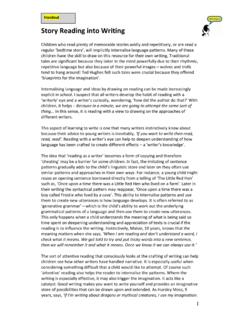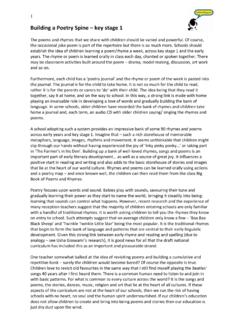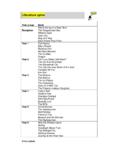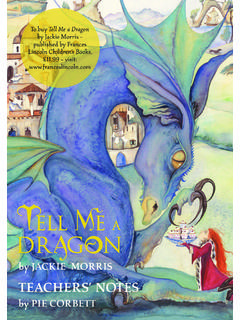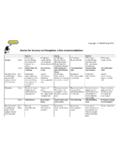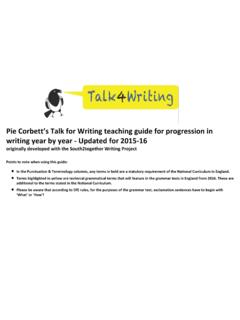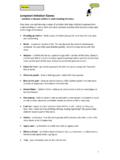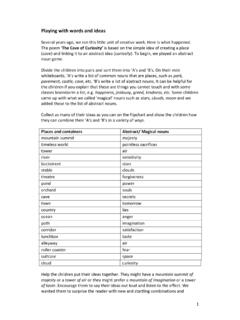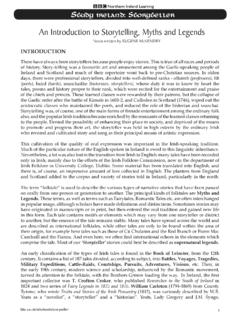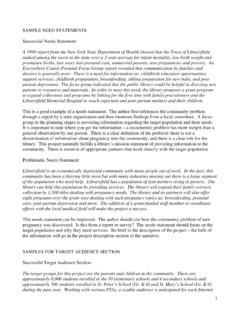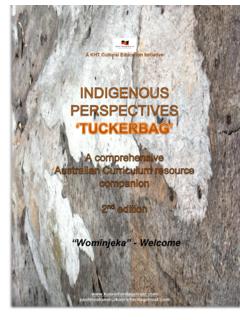Transcription of Inventing Stories - Pie Corbett
1 Inventing Stories In an ideal world, children would have been orally Inventing Stories from Nursery and throughout the EYFS to build the foundations of storytelling and story-making. This would be further supported by learning Stories off by heart to build their narrative storehouses thus giving them the components of Stories to draw upon when having to invent a new one. The key to supporting invention, however, is an understanding of story plots. Pick a simple story design and stick to it. With a simple plot to follow, the act of story-making is made easier, as the writer knows exactly where the story is going. All they have to do then is focus on the quality of what they are putting into the story to make it come alive. Christopher Booker writes about the seven basic story plots, from which all Stories have seemingly evolved (Overcoming the Monster, Rags to Riches, The Quest, Voyage and Return, Comedy, Tragedy and Rebirth). But for children Inventing Stories , they need simple story patterns that they are likely to have experienced in their reading or storytelling .
2 Pie Corbett has named many simple plots so that they are easy to use and support the Inventing process. He talks about the Warning Tale, the Tale of Fear, the Wishing Tale and Finding Tales, to name a few. After discovering the explanation of these story types in Pie s book, How to Teach Fiction Writing KS2, I have adapted some of the more common plots to fit Pie s five-part story structure of: Opening, Build up, Problem, Resolution and Ending. These generic patterns offer simple plots for children to build their Stories around, encompassed in the five story sections that they should be familiar with. They can act as paragraph planners for developing writers, helping them to control the plots of their Stories , but can also become flexible patterns for more confident writers. Here, each section might well be several paragraphs, forming a much richer, descriptive story these plots should not limit writing to only five paragraphs! The patterns can be used boxed-up as presented here, or mapped onto Story Mountains for younger writers, to support the planning process.
3 In order to familiarise the children further with story plots and patterns, it is worth getting them to look for the patterns in reading. What they will no doubt find, is that it is actually quite difficult to identify clear story types in most plots. This is because many Stories are a mixture of several plot types. As children become more familiar with plot patterns they should be encouraged to experiment with them and begin to write blended Stories . For example, a Warning Tale may contain Conquering the Monster as part of the plot and a Finding Tale may also include a Rags to Riches element. They should also be encouraged to box-up plots from model texts themselves, uncovering new patterns and using them to invent new Stories . Also, as the children become more confident writers, they do not need to use the story plots in a linear fashion. For instance, they might start writing at the moment of dilemma and then use a flashback. It is, therefore, important that there is progression in the use of these patterns to meet the needs of the writers as they grow.
4 These plot patterns can be used flexibly to match the level of the writers, the purpose of the writing and stage of development that the writers need to focus on. By regularly revisiting and using these simple plots and building on their content year on year, children should reach a point when they are able to make clear decisions about their Inventing . They will be able to choose a plot, match the characters and settings to it and find a suitable problem to be resolved, all underpinned by the generic structure of that plot. Many schools now choose around six clear story types and teach these to the children each year, so that they develop a bank of patterns to draw upon when they are Inventing . Once children have mastered these plots in their simplest form, they can begin to use them to write more challenging texts. Warning tales, Finding tales and Conquering the Monster Stories seem to be very popular invented Stories with young writers but, with all these simple plots for guidance, anything is possible!
5 Maria Richards, Talk for Writing Primary Expert April 2013 Below are four story map examples: 1. Year 1 Fear Story Text Map 2. Year 2 Warning story text map 3. Year 6 Quest Story Text map 4. Boxed up planning for an adventure story
